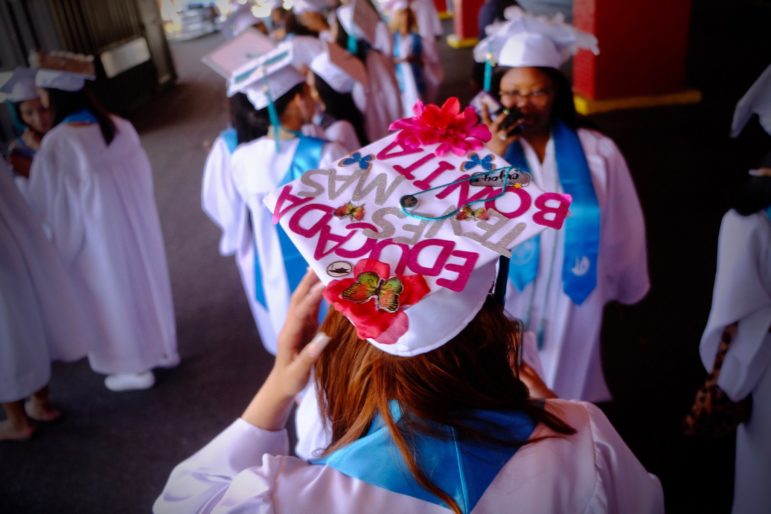The Department of Education will kick off a program to expand the type of aid ELL students receive at existing transfer schools, which serve students who are behind on credits or need additional learning support. But the agency has yet to specify which schools will get those extra resources this school year, which starts next week.

Gerardo Romo/NYC Council Media Unit
NYC high school graduates at a 2019 ceremony in Brooklyn.Lea la versión en español aquí.
The New York City Education Department (DOE) is set to expand support for newcomer immigrants enrolled in the city’s transfer high schools, with additional resources for English Language Learners (ELLs) at six existing programs this fall, City Limits has learned.
But the agency has yet to specify the schools that will get those extra resources and programming this upcoming school year, despite the fact that classes start next week.
Transfer schools serve students who are behind on credits or need additional learning support. While there are dozens across the city, only five specifically serve ELLs—four of them located in Manhattan and one in The Bronx. Immigration advocates have called for years for the city to expand that number to give newly-arrived immigrant youth access to transfer schools in the outer boroughs.
“Transfer schools support students who require alternative forms of education and it is absolutely critical that these unique schools have the programs necessary to support all students—regardless of what language they speak at home,” a DOE spokesperson said.
The Education Collaborative, a coalition of more than 30 community organizations, has been pushing for such an investment, saying ELL students often juggle work and study responsibilities, have fewer school years to catch up with English, and tend to struggle more than their peers to find high schools that meet their academic and social-emotional needs. The group pushed specifically for a three-year, $8.2 million pilot program to reach up to 400 newcomer immigrant students between 16-21 years old, Chalkbeat reported this spring.
The DOE did not specify how much the pilot program it plans to launch this fall will cost, but explained that there is no established cap for the number of students enrolled since transfer schools have open enrollment.
The agency said there will be six schools participating in the pilot program: three in Queens, two in The Bronx, and one in Brooklyn, but did not disclose the names of the schools, and did not respond to City Limits’ requests for those details. The new school year starts next Thursday, Sept. 8.
The DOE did say that it is expecting each of the six schools to enroll a minimum of 25 newcomer immigrants over the upcoming school year, meaning a total of at least 150 new students for the 2022-2023 school year. So far, as of Aug. 30, the city said 25 new students have enrolled across all transfer schools, including five in the pilot program schools.
While it’s not exactly the same as the pilot that advocates proposed, the DOE said its plans will accomplish the shared goal of increasing access and providing opportunities to older newcomer ELLs in communities outside Manhattan.
The DOE said it worked with superintendents to identify schools it felt were well positioned to offer programs to older newcomer English language learners. The six selected schools will provide additional support to students beyond their mandated English as a New Language (ENL) programming, as well as provide professional training to teachers and other staff around supporting the academic and social-emotional needs of ELLs.
Advocates welcomed the news and saw this as the first step, but were awaiting more details.
“My initial reaction is that I’m glad we will have this program,” said Andrea Ortiz, education policy manager at the New York Immigration Coalition, who worked on the pilot program proposal presented to the city by the coalition of organizations.
“To me, it sounds great to have schools in every borough,” Ortiz said over the phone.
“Looking forward to hearing more about it,” said Rita Rodriguez-Engberg, director of the Immigrant Students Rights Project at Advocates for Children of New York.
City officials say the pilot has been in the works since last year and was not a response to the increase in the number of immigrant families seeking asylum in New York over the last few months from the southern border. On Aug. 19, the mayor announced the multi-agency plan Project Open Arms, which establishes guidelines for helping these new arrivals in the enrollment process, though his plan didn’t mention transfer schools.
But advocates say the timing was fortuitous: the recent asylum seekers include more than a thousand school-aged children. Last school year, 43 percent of the city’s public school students spoke a language other than English, according to the DOE.
Between 2015 and 2019 alone, the Migration Policy Institute estimates that 3,400 newly arrived immigrants, ages 16 to 21, weren’t enrolled in school or had not yet received a diploma or an equivalent, and could have potentially benefited from high school programs in the five boroughs. The largest group of the newly arrived unschooled youth lived in The Bronx, followed closely by Queens and Brooklyn.
Two years after the pandemic hit the city, ELL students are still struggling in academic areas, and being out of school for in-person learning for more than a year during the height of the COVID outbreak further widened that learning gap.
While advocates have long pushed for the city to open entirely new transfer high schools to better serve these students, both Ortiz and Rodriguez-Engberg credited the DOE’s latest plan as a first step in that expansion, in which the lessons learned over the next few years will serve to create a more solid model. They acknowledged that creating new schools is a more complicated and time-consuming endeavor, especially now that school budgets have been cut.
“We are focused on expanding and strengthening existing programming designed to provide comprehensive support to students at Transfer Schools,” the DOE spokesperson added.








